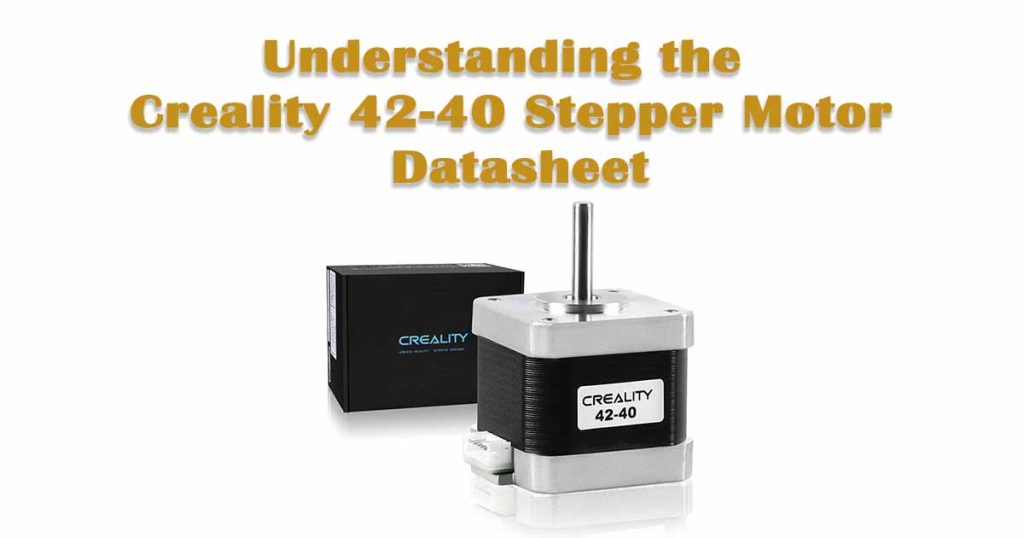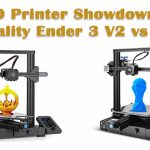In the ever-evolving landscape of 3D printing and CNC machining, the choice of components can make all the difference between mediocrity and excellence. One such crucial component is the stepper motor, a key player in the realm of precise and controlled movement.
Among the array of options available, the Creality 42-40 stepper motor stands out as a beacon of reliability and efficiency.
As we delve into the world of 3D printing and CNC machining, understanding the intricate details of the Creality 42-40 stepper motor is essential. In this article, we embark on an informative journey through its datasheet, unraveling the mysteries behind its performance, specifications, and capabilities.

The “Creality 42-40 stepper motor” has earned a well-deserved reputation among makers, engineers, and hobbyists due to its outstanding craftsmanship and consistent precision. Renowned for its versatility and reliability in various applications, this stepper motor has sparked the interest of numerous enthusiasts seeking to unleash the full capabilities of their 3D printers and CNC machines. If you’re exploring the world of Creality printers and their components, you might also want to check out our comprehensive “Creality Printers Review” for more insights into the best choices available in the market.
In this comprehensive exploration, we will decipher the technical intricacies that make this stepper motor a prized possession among creators. From its electrical specifications to mechanical dimensions, we will leave no stone unturned, shedding light on how the Creality 42-40 stepper motor can elevate your projects to new heights.
Whether you are a seasoned professional or a curious newcomer to the world of 3D printing and CNC machining, this article will serve as your guide to harnessing the power of precision with the Creality 42-40 stepper motor.
Overview of the Creality 42-40 Stepper Motor
The Creality 42-40 Stepper Motor is a powerhouse when it comes to 3D printing and CNC applications. Boasting impressive specs detailed in the Creality 42-40 Stepper Motor Datasheet, this motor is designed to deliver precision and reliability.
With a 1.8-degree step angle, it provides fine control over movements, making it ideal for intricate designs. Its compact yet robust construction ensures durability, while the datasheet offers valuable insights into its electrical and mechanical characteristics.
This motor’s torque performance is particularly noteworthy, offering ample power to move your projects with ease. Whether you’re a seasoned enthusiast or a professional, the Creality 42-40 Stepper Motor, as outlined in its datasheet, promises to be a valuable addition to your machinery, elevating the quality of your creations and pushing the boundaries of your craftsmanship.
Electrical Characteristics
Understanding the electrical characteristics of the Creality 42-40 Stepper Motor is crucial for optimizing its performance in various applications. This datasheet provides invaluable insights into the motor’s specifications, including voltage and current requirements, coil resistance, and inductance values.
These parameters determine how the motor interacts with the control system, affecting its torque, speed, and overall efficiency. By carefully studying these electrical characteristics, users can tailor their control algorithms and power supplies to ensure smooth and precise motion control.
Furthermore, knowledge of these specifications is vital for preventing overheating or overloading the motor, ultimately extending its lifespan and reliability.
In the world of 3D printing and CNC machining, where precision is paramount, a comprehensive understanding of the electrical characteristics of the Creality 42-40 Stepper Motor is a valuable asset.
Mechanical Dimensions
When delving into the intricacies of 3D printing and CNC machining, understanding mechanical dimensions becomes paramount, and the Creality 42-40 Stepper Motor Datasheet is a valuable resource in this regard.
Mechanical dimensions refer to the critical measurements that define the physical characteristics of a component, and in the context of stepper motors, these dimensions are pivotal for precise and accurate movement control.
The Creality 42-40 Stepper Motor Datasheet provides a comprehensive breakdown of these dimensions, encompassing the motor’s size, shaft diameter, mounting hole positions, and more. Engineers and enthusiasts rely on this information to ensure compatibility and optimal integration within their projects.
In essence, mechanical dimensions, as elucidated in the Creality 42-40 Stepper Motor Datasheet, serve as the building blocks for innovation in the world of 3D printing and CNC machining, enabling precise and efficient motion control solutions.
Wiring and Pinout
Understanding the wiring and pinout of a Creality 42-40 stepper motor is crucial for anyone delving into the world of 3D printing or CNC machining. This datasheet provides a roadmap for harnessing the motor’s potential.
By meticulously studying the pinout, enthusiasts can correctly connect the motor to their control boards, ensuring seamless and precise movements in their projects. The right wiring configuration also prevents overheating and damage, prolonging the motor’s lifespan.
Additionally, comprehending the pinout helps users troubleshoot any issues that may arise during operation, making it an invaluable resource for both beginners and experienced makers.
In essence, mastering the intricacies of the Creality 42-40 stepper motor’s wiring and pinout opens the door to limitless possibilities in the realm of DIY fabrication and automation.
Torque and Holding Torque
When delving into the intricacies of stepper motors, understanding the concepts of torque and holding torque is paramount. In the context of the Creality 42-40 Stepper Motor Datasheet, these parameters play a pivotal role. Torque, measured in Newton-meters (Nm), represents the rotational force exerted by the motor.
It determines the motor’s ability to move loads and is crucial in applications where precise control is needed, such as 3D printing and CNC machining. Holding torque, on the other hand, is the static torque a stepper motor can maintain without rotating.
This attribute ensures the motor can lock into a position, preventing unintended movement when stationary. For users of the Creality 42-40 Stepper Motor, understanding these torque specifications from the datasheet is essential for optimizing performance and achieving precise motion control in various applications.
Step Angle and Resolution
When delving into the world of 3D printing, the Creality 42-40 stepper motor’s datasheet becomes a crucial reference point, shedding light on its essential specifications. Among these key attributes, the step angle and resolution stand out as vital parameters.
The step angle, typically measured in degrees, determines the motor’s precision in turning. In the case of the Creality 42-40, this value is crucial in ensuring accurate movement and positioning of the 3D printer’s components.
Resolution, on the other hand, defines the smallest incremental movement the motor can achieve. A finer resolution equates to more precise and detailed prints.
Understanding these specifications from the datasheet empowers 3D printing enthusiasts to optimize their machines for superior output quality, making the Creality 42-40 stepper motor a go-to choice for those seeking precision and reliability in their projects.
Thermal Characteristics
Understanding the thermal characteristics of the Creality 42-40 Stepper Motor is crucial for optimizing its performance and longevity. These motors play a pivotal role in 3D printing and CNC machines, where precision and reliability are paramount.
The thermal characteristics refer to how the motor handles heat generated during operation. Excessive heat can lead to performance degradation and even motor failure.
By examining the datasheet for the Creality 42-40 Stepper Motor, enthusiasts and engineers can glean essential information about its thermal properties, such as the maximum operating temperature and thermal resistance.
This knowledge empowers users to make informed decisions regarding cooling solutions, duty cycles, and motor current settings, ensuring that the stepper motor remains within its safe thermal limits.
A thorough understanding of thermal characteristics is, therefore, fundamental in harnessing the full potential of this versatile motor in various applications.
Environmental Considerations
When delving into the Creality 42-40 Stepper Motor Datasheet, it becomes evident that environmental considerations play a pivotal role in the broader context of manufacturing and technology. As industries continue to evolve and innovate, it is crucial to assess the environmental impact of the components we utilize.
Stepper motors are integral in various applications, including 3D printing and CNC machines, where precision and reliability are paramount. However, examining their environmental footprint is equally important. Creality, a renowned name in the 3D printing industry, recognizes this responsibility.
By providing comprehensive datasheets and information on their stepper motors, they empower consumers and manufacturers to make informed choices that align with sustainability goals.
This proactive approach not only enhances product transparency but also encourages a greener, more environmentally conscious approach to technology adoption. It underscores the importance of holistic thinking in an era where environmental considerations are more critical than ever.
Recommended Driver and Voltage
When delving into the technical specifications of the Creality 42-40 Stepper Motor, understanding the recommended driver and voltage is paramount. This particular stepper motor is designed to operate optimally with a specific driver and voltage range, ensuring precision and reliability in 3D printing and CNC applications.
The datasheet reveals that the recommended driver for the Creality 42-40 Stepper Motor is typically an A4988 or TMC2208, both well-regarded choices in the maker community for their compatibility and performance.
Furthermore, the voltage range specified in the datasheet, typically between 12V and 24V, provides flexibility while maintaining motor stability.
By adhering to these recommendations, users can unlock the full potential of this stepper motor, achieving smoother motion control and higher quality output in their projects, whether they are crafting intricate prototypes or artistic masterpieces.
Wiring Examples and Configurations
When it comes to delving into the fascinating world of 3D printing, understanding the intricacies of your Creality 42-40 stepper motor is paramount.
The Creality 42-40 stepper motor datasheet provides valuable insights into its specifications and capabilities, but knowing how to wire it effectively can elevate your 3D printing projects to new heights. Wiring examples and configurations play a pivotal role in ensuring the seamless operation of your stepper motor.
Whether you’re a seasoned 3D printing enthusiast or a novice looking to embark on this creative journey, exploring these wiring examples can be a game-changer. Properly configuring your stepper motor can enhance precision, reduce errors, and optimize your printing process.
So, dive into the world of wiring configurations, and unlock the full potential of your Creality 42-40 stepper motor for an unparalleled 3D printing experience.
Safety and Maintenance Tips
When it comes to working with the Creality 42-40 Stepper Motor, safety and maintenance should be at the forefront of your mind. This powerful motor is a vital component in various 3D printers and CNC machines, making it essential to ensure its longevity and safe operation.
To start, regularly inspect the motor for any loose wires or connections, as loose connections can lead to malfunction or even fires. Additionally, keep the motor well-lubricated to reduce friction and prevent overheating.
Safety is paramount, so always disconnect power sources when performing maintenance or adjustments. Finally, adhere to the manufacturer’s guidelines and the motor’s datasheet for voltage and current specifications to avoid overloading.
By following these safety and maintenance tips, you can ensure the optimal performance and longevity of your Creality 42-40 Stepper Motor while prioritizing safety in your workspace.
Conclusion
In the world of 3D printing, CNC machining, and automation, the Creality 42-40 stepper motor datasheet is an invaluable resource. It provides a comprehensive overview of the motor’s specifications, allowing users to make informed decisions when integrating it into their projects.
Understanding the electrical characteristics, mechanical dimensions, torque values, step angle, and other vital parameters is crucial for achieving precision and reliability in motion control applications. Additionally, the datasheet offers guidance on wiring, driver selection, and maintenance, ensuring that your motor operates optimally for years to come.
As you embark on your journey with the Creality 42-40 stepper motor, remember that the datasheet is your trusted companion. By referring to it and applying the knowledge gained from this article, you can harness the full potential of this remarkable motor and unlock new possibilities in your projects.

